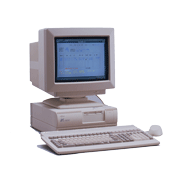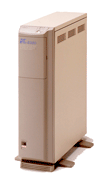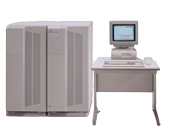The Fujitsu K-6000 series of office computers, compliant with MESSAGE 90s,*1 a concept Fujitsu announced in May 1991, was the successor to the K-600Si series. Together with the K-1500 series of office workstations, Fujitsu announced nine lines and 24 models*2 in October 1992. In keeping with the role of the new series, Fujitsu also supplied a new operating system, ASP, as well as the RDB/6000 relational database, based on the international-standard SQL database language, and the RDA/SV remote database access function.
Features of the K-6000 series:
- (1) Open-system support
- Fujitsu ensured connectivity with LAN-connected PCs and workstations, compliance with MESSAGE 90s, and a user-friendly environment for PC software from independent software vendors (ISV).
- (2) Easy usability and operability
- Fujitsu improved the GUI and added fax connectivity and other features.
- *1. MESSAGE 90s:
- This was a new concept announced by Fujitsu in May 1991 for constructing information systems for the 1990s. In view of the coming end-user computing era, this concept aimed to create an environment, that included many kinds of ISV products, in which end users could freely access via PCs or workstations all the various information accumulated on a corporation’s systems. To make this happen, MESSAGE 90s enabled sharing of data across different operating systems and applications. More specifically, this concept observed how data was used within information systems, divided this usage into the three patterns below, and enabled these patterns to be arranged freely.
- [1] Operational pattern
- This pattern involves the routine and repeated processing of core data and operational data.
- [2] Managerial pattern
- This pattern involves analysis and decision-making support using management data and data released to departments.
- [3] Office data pattern
- This pattern focuses on the use of personal information in offices with word processing and spreadsheet programs.
- *2. The K-6000 series consisted of five lines and 14 models (see table below).
- The K-1500 series consisted of three lines and six models (K-1500LX/10, 30; K-1500LT/10, 30; K-1500NB/05, 10).
| Line (model names below) | K-6300 | K-6300 | K-6500 | K-6700 | K-6900 | |||||||||
|---|---|---|---|---|---|---|---|---|---|---|---|---|---|---|
| DT | 10 | 20 | 10 | 20 | 30 | 10 | 20 | 30 | 40 | 10 | 20 | 30 | 40 | |
| Introduced | October 1992 | |||||||||||||
| Main memory capacity | 2MB〜 8MB |
4MB〜 24MB |
6MB〜 60MB |
16MB〜 160MB |
32MB〜 384MB |
|||||||||
| Disk capacity | 135MB〜 752MB |
292MB〜 3.8GB |
460MB〜 11.0GB |
1.1GB〜 53.3GB |
3.0GB〜 99.1GB |
|||||||||
| Max. number of directly connectable workstations | 6 | 40 | 112 | 336 | 896 | |||||||||
| Max. number of LAN connectable workstations*1 | 1024 | 2048 | ||||||||||||
| Max. number of LAN connectable workstations*1 | 2 | 9 | 49 | 89 | 128 | |||||||||
| Operating system | ASP*2 | |||||||||||||
| Other details |
|
|||||||||||||
*1. Total of the maximum number of workstations either directly connected or connected over a LAN
*2. ASP replaced the previous CSP/FX operating system. While maintaining compatibility with CSP/FX, ASP was designed to be more user friendly and have better network connectivity, through TCP/IP support, improved file management, and better PC connectivity.
The specifications above were correct at the time the products were announced. Some specifications were later revised due to product upgrades.




